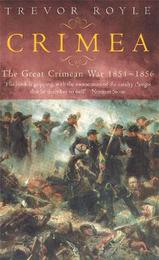
|
Crimea: The Great Crimean War 1854-1856
Paperback / softback
Main Details
Description
The Crimean War is one of the most compelling subjects in British history. The story of Florence Nightingale, "the Lady with the Lamp", the heroic reporting of William Russell, "The Times" intrepid correspondent, and the sonorous names of the battles are familiar from schooldays and ingrained deep within the British military consciousness. In this volume, Trevor Royle demonstrates how the Crimean War was a watershed in world history: coming between the defeat of Napoleon in 1815 and the opening shots of the First World War in 1914 it pointed the way to what mass warfare would be like for soldiers in the 20th century.
Author Biography
Trevor Royle is a well-known writer and broadcaster on military history. His two most recent books are highly praised biographies of two of Britain's best-known yet unorthodox imperial servants - Glubb Pasha and Orde Wingate.
Reviews'a tour de force, a splendidly written account of the diplomatic and military blunders that signalled the end of what promised to be a century of peace' - LITERARY REVIEW 'his book is gripping, with the momentum of the cavalry charges that he describes so well' - Norman Stone 'Trevor Royle's new history tells the whole story of the Crimean War and puts it in its context, drawing on a variety of new sources as well as representing classic accounts. Overall it is a powerful piece of narrative history. The Battle of the Alma, for instance, after which so many London streets and pubs have been named, is described in a vivid chapter, a "victory that owed everything to the resolve and courage of the British infantrymen." Advancing up a heavily defended hill, one young officer later reported "the fire was so hot that you could hardly conceive it possible for anything the size of a rabbit not to be killed." Royle then adds: "Minutes later he was shot in the cheek, losing 23 teeth and part of his tongue." This balance of excitement and terror is well captured throughout the work. (The Irish journalist William Russell reported a different perspective on the battle: "There was a sickening, sour, fetid smell everywhere and the grass was slippy with blood.") Royle gives powerful accounts of the famous military engagements, the Charge of the Light Brigade and Thin Red Line at the Battle of Balaklava, the "ferocious hand-to-hand fighting" of the Battle of Inkerman. But he also places these flashes of military adventure in the larger context. This was a war fought in many places other than the Crimea--Royle's chapter on the fighting in Armenia, for instance, is entitled "the forgotten war", and there were also naval campaigns in the Baltic and Pacific. The British suffered casualties of 19,584 overall, but only one tenth of this number actually died on the battlefield; the rest died of disease. Royle's chapter on Florence Nightingale and her nurses recaptures the horror her contemporaries felt at hearing about the dreadful conditions of the Field Hospitals. Reading these accounts it is amazing that any wounded man survived at all: "Surgeons operated with unsterilised instruments, wounds were dressed with lint from discarded linen and operating tables were encrusted with the blood and detritus from previous patients." The whole book is a vivid and definitive read.' - Adam Roberts, AMAZON.CO.UK REVIEW
|